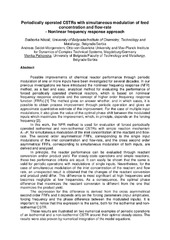Приказ основних података о документу
Periodically operated CSTRs with simultaneous modulation of feed concentration and flow-rate- Nonlinear frequency response approach
| dc.creator | Nikolić, Daliborka | |
| dc.creator | Seidel-Morgenstern, Andreas | |
| dc.creator | Petkovska, Menka | |
| dc.date.accessioned | 2021-03-10T12:37:38Z | |
| dc.date.available | 2021-03-10T12:37:38Z | |
| dc.date.issued | 2015 | |
| dc.identifier.uri | http://TechnoRep.tmf.bg.ac.rs/handle/123456789/2874 | |
| dc.description.abstract | Possible improvements of chemical reactor performance through periodic modulation of one or more inputs have been investigated for several decades. In our previous investigations we have introduced the nonlinear frequency response (NFR) method, as a fast and easy, analytical method for evaluating the performance of forced periodically operated chemical reactors, which is based on nonlinear frequency response analysis and the concept of higher order frequency response function (FRFs).[1] The method gives an answer whether, and in which cases, it is possible to obtain process improvement through periodic operation and gives an approximate quantitative estimate of the improvement. For the case of multiple input modulations, it also gives the value of the optimal phase shift between the modulated inputs which maximizes the improvement, which, in principle, depends on the forcing frequency [2]. In this work, the NFR method is used for evaluation of forced periodically operated isothermal and non-isothermal CSTRs with simple reaction mechanism A→P, for simultaneous modulation of the inlet concentration of the reactant and flow-rate. The second order asymmetrical FRFs, corresponding to the single input modulations of the inlet concentration and flow-rate, and the cross second order asymmetrical FRFs, corresponding to simultaneous modulation of both inputs, are derived and analyzed. In principle, the reactor performance can be evaluated through reactant conversion and/or product yield. For steady-state operations and simple reactions, these two performance criteria are equal. It can easily be shown that the same is valid for periodic operations with modulations of single inputs. Nevertheless, for the case of simultaneous modulation of the inlet concentration of the reactant and flow rate, an unexpected result is obtained that the changes of the reactant conversion and product yield differ. This difference is most significant at high frequencies and becomes negligible at low frequencies. As a consequence, the optimal phase difference that maximizes the reactant conversion is different from the one that maximizes the product yield. The expression for this difference is derived from the cross asymmetrical second order FRFs and it depends only on the forcing parameters (input amplitudes, forcing frequency and the phase difference between the modulated inputs). It is important to notice that this expression is the same, both for the isothermal and non-isothermal CSTR. These results are illustrated on two numerical examples of periodic operations of an isothermal and a non-isothermal CSTR around their optimal steady-states. The results were also proven by numerical integration of the model equations. | en |
| dc.relation | info:eu-repo/grantAgreement/MESTD/Integrated and Interdisciplinary Research (IIR or III)/45001/RS// | |
| dc.relation | info:eu-repo/grantAgreement/MESTD/Basic Research (BR or ON)/172022/RS// | |
| dc.rights | openAccess | |
| dc.rights.uri | https://creativecommons.org/licenses/by/4.0/ | |
| dc.source | 10th European Congress of Chemical Engineering (ECCE 10), Nice, France | |
| dc.subject | chemical reactor | sr |
| dc.subject | nonlinear frequency response | sr |
| dc.subject | steady-states | sr |
| dc.subject | model | sr |
| dc.subject | numerical integration | sr |
| dc.title | Periodically operated CSTRs with simultaneous modulation of feed concentration and flow-rate- Nonlinear frequency response approach | en |
| dc.type | conferenceObject | |
| dc.rights.license | BY | |
| dc.identifier.fulltext | http://TechnoRep.tmf.bg.ac.rs/bitstream/id/942/2871.pdf | |
| dc.identifier.rcub | https://hdl.handle.net/21.15107/rcub_technorep_2874 | |
| dc.type.version | publishedVersion |

